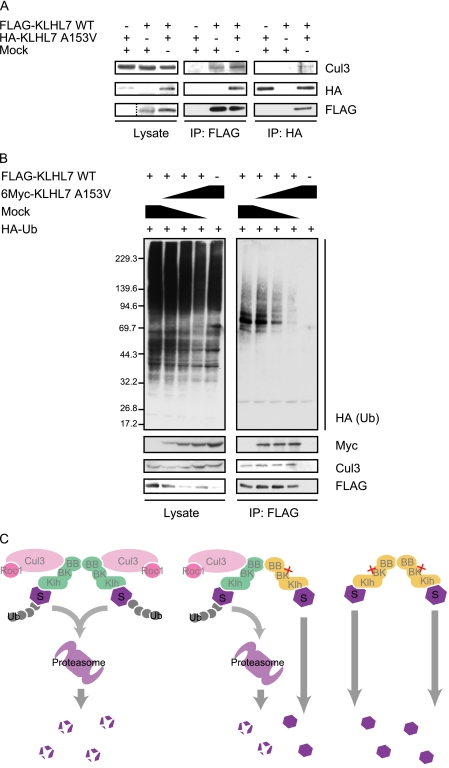FIGURE 6.
KLHL7 A153V attenuates Cul3-KLHL7 ligase activity. A, HCT116 cells were transfected with FLAG-KLHL7 and HA-KLHL7 A153V as indicated. The cell lysates were immunoprecipitated (IP) with anti-FLAG or anti-HA antibodies and immunoblotted with anti-Cul3, anti-HA, and anti-FLAG antibodies. B, HCT116 cells were transfected with FLAG-KLHL7, HA-Ub, and increasing amounts of 6Myc-KLHL7 A153V. The cells were treated with 20 μm MG132 for 1 h prior to harvesting and immunoprecipitated with anti-FLAG antibodies. Immunoblot analyses were done using anti-HA, anti-Myc, anti-Cul3, and anti-FLAG antibodies. C, molecular models of KLHL7-mediated ubiquitination. KLHL7 is indicated in green, the Ala-153 mutant in yellow, and the substrate as S. The domains of KLHL7 are as indicated: BB, BTB; BK, BACK; Klh, Kelch. The wild-type KLHL7 homodimer binds to two sets of Cul3/Roc and targets the substrates for ubiquitination (left panel). The heterodimer of wild-type and Ala-153 mutant can only bind to one set of Cul3/Roc1 and may ubiquitinate one of the two substrates, or not at all (middle panel). The Ala-153 mutant homodimer cannot bind to Cul3/Roc1 and fails to target the substrates for ubiquitination (right panel).

